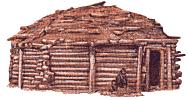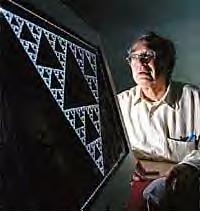|
"Going into science was a whole accident,"
Begay said recently in his office at Los Alamos National Laboratory. "No nothing."
But Begay's accomplishments are noteworthy by any
standards: A doctorate degree in nuclear physics, experience on NASA's high-energy gamma ray project, teaching
fellowships at Stanford University and the University of Maryland and a tenure of nearly 30 years in LANL's laser
program.
Lab director John Browne has lauded Begay as a
"unique resource" for the scientific community. Begay has been featured in a textbook, "Native American
Biographies." And he has been singled out for his lifetime of achievement by the Society of Advancement of
Chicanos and Native Americans in Science.
It has been a long road from the red dirt of the
Navajo Reservation to the thermonuclear research laboratories of Los Alamos.
 But Begay has found fascinating parallels between Navajo concepts of religion and medicine and
modern scientific thought. It has led him to believe Navajo students might be better prepared for understanding
science and math than non-Navajos. But Begay has found fascinating parallels between Navajo concepts of religion and medicine and
modern scientific thought. It has led him to believe Navajo students might be better prepared for understanding
science and math than non-Navajos.
For example:
- Navajos live in eight-sided hogans and count their sheep in base eight arithmetic,
the basis of computer science, not in the base 10 that is the foundation of American mathematics;
- The designs incorporated in Navajo rugs require complicated geometry, although weavers
never refer to their design process as geometry;
- Navajo belief centers on the origin of the natural world and theories of natural phenomena
-- much like the laws of physics;
- Ancient Navajo scientific concepts include ideas similar to gravity, fusion energy,
solar radiation and the modern gas discharge laser.
- "Growing up in a Navajo household, we don't separate religion and the way science
works," said Begay. "I think it prepared me for school and the study of mathematics and science."
Devoted to Science
Begay sits behind a computer at LANL, where he
has worked in the area of thermonuclear fusion since 1971. In corduroy pants and well-worn canvas high-top sneakers,
his graying hair askew and three pairs of glasses at the ready, Begay is the picture of a man devoted to scientific
theory.
He recalled with humor how close he came to walking
behind a plow on his mother's farm outside Shiprock instead of sitting here.
Born to a father who was Navajo and a mother who
was Navajo and Ute, Begay spoke both Indian languages but did not learn English until the BIA school in Ignacio,
Colo., when he was 10.
After the BIA school, he enlisted in the Army and
went to fight in the Korean War. When he came home in 1955, he returned to his mother's 30-acre farm with the intention
of growing corn and raising children.
The Navajo tribe had come into federal education
money for veterans and was recruiting Navajos who might go to college. Begay was plucked from the Shiprock community
and tribal officials decided he would study mechanical engineering.
He hitchhiked to Albuquerque and enrolled in the University of New Mexico on the strength of his BIA farming certificate
and a promise that he would go to high-school classes at night. English classes were troublesome for Begay, but
he easily learned German, which is similar in structure to Navajo, and he quickly picked up science and math concepts.
At the urging of professors, Begay changed his major to physics and graduated in 1961, still lacking a high-school
diploma.
Begay left UNM in 1971 with seven children, a pickup
truck and a doctorate in nuclear physics. He headed for a job at Los Alamos.
World of Possibilities
It took an innocent question from his mother in
the early 1970s -- shortly after he had earned his Ph.D. and had started work at the lab -- to spur Begay to try
to quantify the similarities between Navajos' religious naturalism and modern scientific thought.
"You've got this doctorate," Begay's
mother said to him when he visited the reservation. "But tell us in Navajo what physics is."
Her question and his answer are why Begay leaves
Los Alamos several times a year and drives to Crownpoint or Shiprock or Kinlichee or Tuba City or other reservation
communities to talk to Navajo middle school students about science and math concepts.
Begay's goal is broader than recruiting the next
Navajo nuclear physicist.
"My aim is math literacy, computer literacy,
science literacy," Begay said. "It opens up their choices."
At Tuba City Junior High School on the far western
edge of the reservation, students have been wowed with colorful computer demonstrations of fractal geometry and
a lecture about the similarities between Navajo scientific concepts and modern Western science, teacher Del Glasgow
said. More important than the details of Begay's message is the man delivering it, Glasgow said.
"With him the kids have a role model of a
Navajo who is in a science career and with a Ph.D.," Glasgow said. "It shows them what is possible."
|

